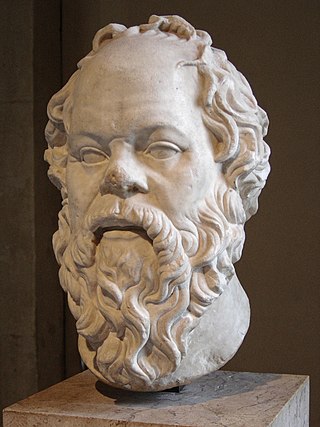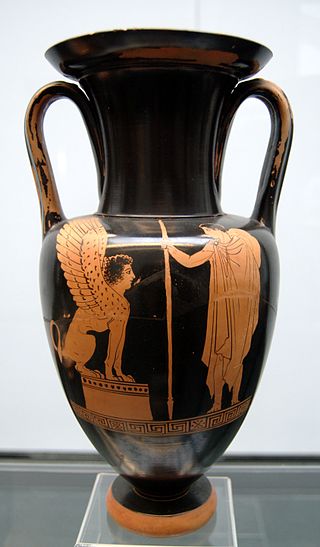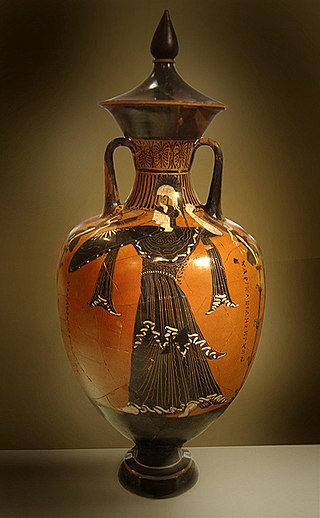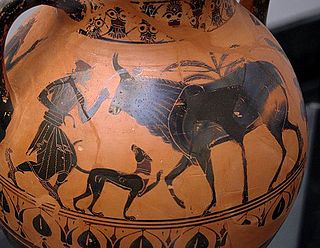
The Roman calendar was the calendar used by the Roman Kingdom and Roman Republic. Although the term is primarily used for Rome's pre-Julian calendars, it is often used inclusively of the Julian calendar established by the reforms of the dictator Julius Caesar and emperor Augustus in the late 1st century BC.

The 5th century BC started the first day of 500 BC and ended the last day of 401 BC.
This article concerns the period 549 BC – 540 BC.
This article concerns the period 459 BC – 450 BC.

An amphora is a type of container with a pointed bottom and characteristic shape and size which fit tightly against each other in storage rooms and packages, tied together with rope and delivered by land or sea. The size and shape have been determined from at least as early as the Neolithic Period. Amphorae were used in vast numbers for the transport and storage of various products, both liquid and dry, but mostly for wine. They are most often ceramic, but examples in metals and other materials have been found. Versions of the amphorae were one of many shapes used in Ancient Greek vase painting.

Year 200 BC was a year of the pre-Julian Roman calendar. At the time it was known as the Year of the Consulship of Maximus and Cotta. The denomination 200 BC for this year has been used since the early medieval period, when the Anno Domini calendar era became the prevalent method in Europe for naming years.

Year 450 BC was a year of the pre-Julian Roman calendar. At the time, it was known as the Second year of the decemviri. The denomination 450 BC for this year has been used since the early medieval period, when the Anno Domini calendar era became the prevalent method in Europe for naming years.

Year 470 BC was a year of the pre-Julian Roman calendar. At the time, it was known as the Year of the Consulship of Potitus and Mamercus. The denomination 470 BC for this year has been used since the early medieval period, when the Anno Domini calendar era became the prevalent method in Europe for naming years.

Xanthos was an ancient city near the present-day village of Kınık, in Antalya Province, Turkey. The ruins are located on a hill on the left bank of the River Xanthos. The number and quality of the surviving tombs at Xanthos are a notable feature of the site, which, together with nearby Letoon, was declared to be a UNESCO World Heritage Site in 1988.
The year 570 BC was a year of the pre-Julian Roman calendar. In the Roman Empire, it was known as year 184 Ab urbe condita. The denomination 570 BC for this year has been used since the early medieval period, when the Anno Domini calendar era became the prevalent method in Europe for naming years.
A calendar era is the period of time elapsed since one epoch of a calendar and, if it exists, before the next one. For example, it is the year 2023 as per the Gregorian calendar, which numbers its years in the Western Christian era.

Pottery, due to its relative durability, comprises a large part of the archaeological record of ancient Greece, and since there is so much of it, it has exerted a disproportionately large influence on our understanding of Greek society. The shards of pots discarded or buried in the 1st millennium BC are still the best guide available to understand the customary life and mind of the ancient Greeks. There were several vessels produced locally for everyday and kitchen use, yet finer pottery from regions such as Attica was imported by other civilizations throughout the Mediterranean, such as the Etruscans in Italy. There were a multitude of specific regional varieties, such as the South Italian ancient Greek pottery.

Black-figure pottery painting, also known as the black-figure style or black-figure ceramic, is one of the styles of painting on antique Greek vases. It was especially common between the 7th and 5th centuries BCE, although there are specimens dating as late as the 2nd century BCE. Stylistically it can be distinguished from the preceding orientalizing period and the subsequent red-figure pottery style.

The ancient Roman units of measurement were primarily founded on the Hellenic system, which in turn was influenced by the Egyptian and the Mesopotamian system. The Roman units were comparatively consistent and well documented.

The Achilles Painter was a vase-painter active ca. 470–425 BC. His name vase is an amphora, Vatican 16571, in the Vatican museums depicting Achilles and dated 450–445 BC. An armed and armored Achilles gazes pensively to the right with one hand on his hip. The other hand holds a spear. On the opposite surface a woman performs libation.

Panathenaic amphorae were the amphorae, large ceramic vessels, that contained the olive oil given as prizes in the Panathenaic Games. Some were ten imperial gallons and 60–70 cm (24–28 in) high. This oil came from the sacred grove of Athena at Akademia. The amphorae which held it had the distinctive form of tight handles, narrow neck and feet, and they were decorated with consistent symbols, in a standard form using the black figure technique, and continued to be so, long after the black figure style had fallen out of fashion. Some Panathenaic amphorae depicted Athena Promachos, goddess of war, advancing between columns brandishing a spear and wearing the aegis, and next to her the inscription τῶν Ἀθήνηθεν ἄθλων "(one) of the prizes from Athens". On the back of the vase was a representation of the event for which it was an award. Sometimes roosters are depicted perched on top of the columns. The significance of the roosters remains a mystery. Later amphorae also had that year's archon's name written on it making finds of those vases archaeologically important.
Geometric art is a phase of Greek art, characterized largely by geometric motifs in vase painting, that flourished towards the end of the Greek Dark Ages, c. 900–700 BC. Its center was in Athens, and from there the style spread among the trading cities of the Aegean. The Greek Dark Ages lasted from c. 1100 to 750 BC and include two periods, the Protogeometric period and the Geometric period, in reference to the characteristic pottery style. The vases had various uses or purposes within Greek society, including, but not limited to, funerary vases and symposium vases.

The pottery of ancient Greece has a long history and the form of Greek vase shapes has had a continuous evolution from Minoan pottery down to the Hellenistic period. As Gisela Richter puts it, the forms of these vases find their "happiest expression" in the 5th and 6th centuries BC, yet it has been possible to date vases thanks to the variation in a form’s shape over time, a fact particularly useful when dating unpainted or plain black-gloss ware.

South Italian is a designation for ancient Greek pottery fabricated in Magna Graecia largely during the 4th century BC. The fact that Greek Southern Italy produced its own red-figure pottery as early as the end of the 5th century BC was first established by Adolf Furtwaengler in 1893. Prior to that this pottery had been first designated as "Etruscan" and then as "Attic." Archaeological proof that this pottery was actually being produced in South Italy first came in 1973 when a workshop and kilns with misfirings and broken wares was first excavated at Metaponto, proving that the Amykos Painter was located there rather than in Athens.

The Northampton Group was a stylistic group of ancient Greek amphorae in the black-figure style.













